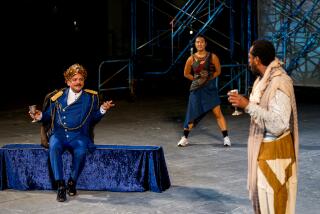‘GREEN CARD’: FOUR POINTS OF VIEW : A PLAY THAT LOOKS AT FACES
- Share via
Friday, July 4, marks the 100th birthday of the Statue of Liberty. The Mark Taper Forum’s current show, “Green Card,” concerns the immigrants attracted by Miss Liberty’s torch from the days of Ellis Island to the time of the boat people. Here are points of view on JoAnne Akalaitis’ play from writers whose families came to the United States from Korea, Mexico, Germany and Ireland: Sophia Kim finds “Green Card” patronizing. Victor Valle thinks it strikes a nerve. For Mark Wurm, it’s bad rhetoric. For Dan Sullivan, it’s good poetry.
“Green Card” doesn’t bring out the Irish in me, but it does bring out the theater critic. We are talking about a play here, not about a committee report.
If it were a committee report, one would send it back to the committee for not making its point of view clear. One viewer thinks that it puts today’s Asian immigrants in the same boat with yesterday’s Jewish immigrants. Another viewer could argue that it shows Asian immigrants seized with a new kind of culture shock, virulent enough to kill a robust man in his sleep.
An effective position paper doesn’t invite multiple interpretations. But a work of art does. And “Green Card” intends to be a work of art, addressed to the intuitive half of the brain, which can embrace contradictions, rather than to the measuring half.
This is clear from the form of the piece. Rather than give us a straightforward platform history of U.S. immigration, author-director JoAnne Akalaitis arranges her material without regard to time, place or cause-and-effect. An Ellis Island image will rub up against a passage about the boat people, followed by a guy doing a Lenny Bruce routine (Jesse Borrego), followed by a Salvadoran cleaning woman (Alma Martinez) talking about the American woman she works for.
Flick, flick, flick. This is the way TV deals out its images and we are right to be wary of it when its aim is to sell us a hair spray or a political candidate. But it can also be used to look at a subject from a number of angles at once. Rather than deadening thought, it can provoke it.
Instead of telling us what to think about immigration, “Green Card” suggests how we should think about it--delicately, with respect for the complexities of the problem and with particular concern for its human face, often neglected when the logical people tackle a problem.
It suggests that we rational Anglo-Saxons haven’t been been nearly as rational on the subject as we like to pretend. Besides slapping an insulting racial label on every non-English-speaking immigrant ( wop , chink , yid --that’s the point of the Bruce excerpt), we have worked out absurd pseudoscientific theories to prove his inferiority. “Green Card” begins on this note, a reminder that the United States has always been suspicious of its newcomers, being “foreigners.”
One way to belittle the reality of the foreigner--here and abroad--is to see him as an exotic. “Green Card” shows us a U.S. diplomat’s wife (Mimi Seton) cooing about Buddhist monks in their perfect orange robes, as though they were background figures in a Vogue layout. One doesn’t trust dress-extras to run their own country.
Later, a Central American recalls how the Americans sent his people some portable toilets that were better built than their houses. The anecdote isn’t as devastating as the way it’s told. Just for a minute, actor George Galvan drops his charming “native accent” and you see a real man, angry and potentially dangerous.
At another point, the cast infiltrates the auditorium and begins asking audience members eccentric questions: “Do you eat too fast? Are you sure of getting a warm welcome from your friends?” This looks like a pointless leftover from the days of the Living Theatre, but look again. It puts the viewer in the position of a greenhorn trying to cope with an immigration official who is apparently allowed to ask him anything in the world. (I know a woman who was asked, “When did you last have intercourse with your husband?”)
“Green Card” is a kaleidoscope, not an editorial. It doesn’t propose to settle the immigration question, but to embody the question, in images a theater audience can respond to. Miss Liberty with a worried crease in her forehead. A line of people--brown, black, white, yellow--waiting for a bus which may not come.
That’s the kind of truth that the artist puts his finger on. He doesn’t write committee reports. But the committee would do well to consult him.
More to Read
The biggest entertainment stories
Get our big stories about Hollywood, film, television, music, arts, culture and more right in your inbox as soon as they publish.
You may occasionally receive promotional content from the Los Angeles Times.










